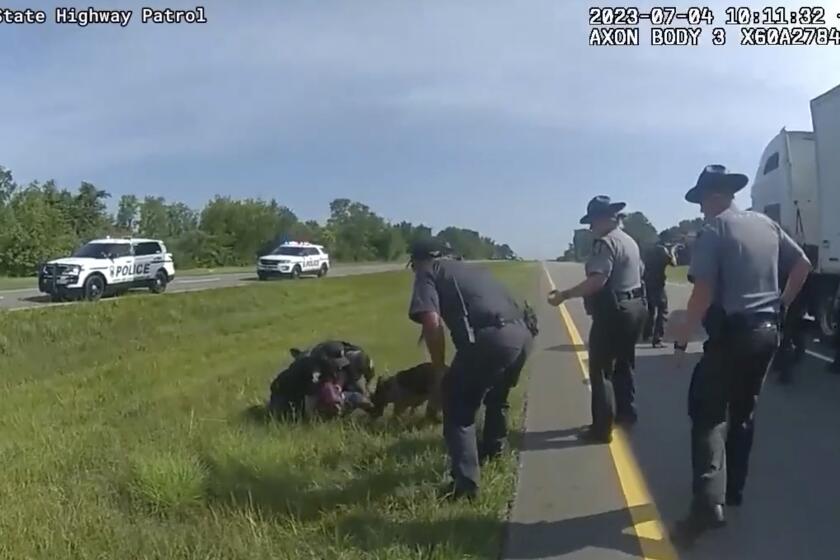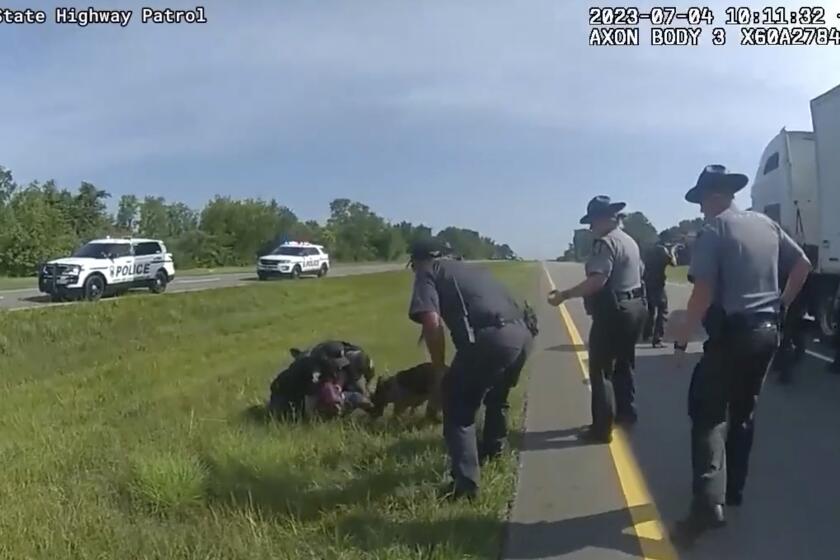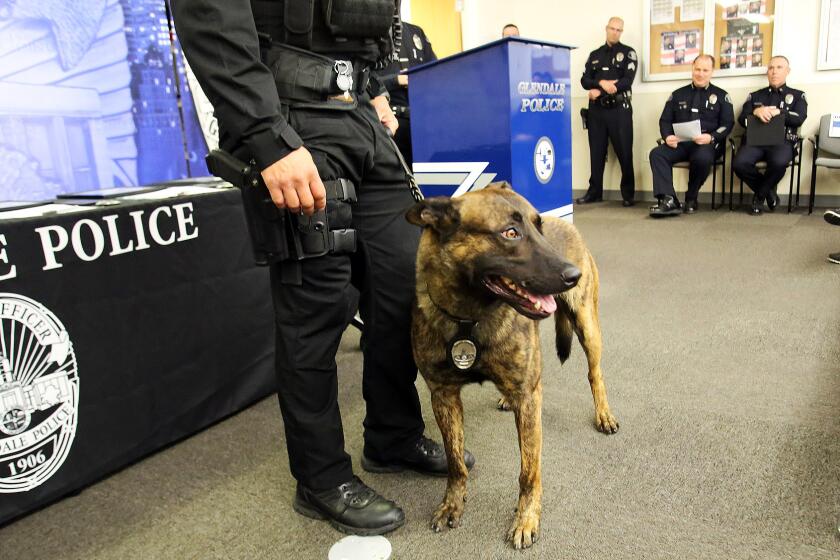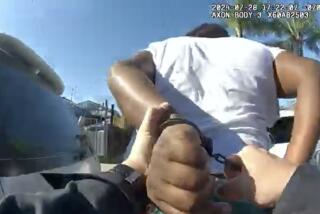A police dog attacked a Black trucker on his knees. An Ohio city deals with the aftermath
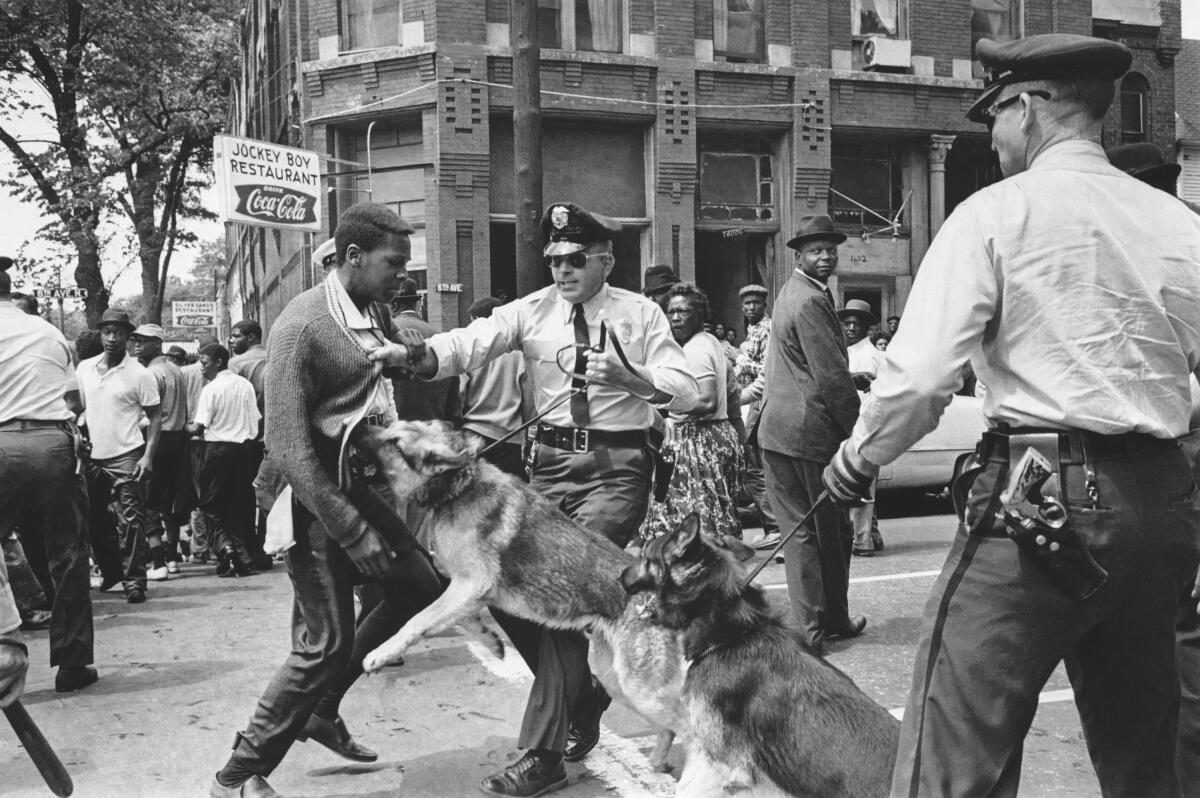
- Share via
CIRCLEVILLE, Ohio — As Jadarrius Rose drove his 18-wheeler through rural Ohio, a simple missing mudflap caught the Highway Patrol’s eye. The trip ended with a police dog’s powerful jaws clamping down on Rose even as he tried to surrender.
As he stood with his hands up beside the highway on July 4, at least six law enforcement officers surrounded him at a distance, one calling forcefully to the K-9 handler: “Do not release the dog,” Highway Patrol video shows.
Nevertheless, a Belgian Malinois is seen on the video either breaking free or being set loose. At first, the animal seems confused, racing past Rose toward officers at the far end of the truck, then turning back and running for Rose, then 23.
By then the trucker is on his knees, hands still high, as an officer shouts, “Get the dog off of him!”
That day, Rose joined a long list of Black Americans attacked by police dogs, a history well documented by journalists, academics and filmmakers. Investigations into such cases have been launched regularly in recent years. For some, the scenes hark back to the civil rights movement, when authorities often turned dogs and fire hoses on peaceful Black protesters marching for equality.
The Associated Press captured one such attack in a photograph from Birmingham, Ala., taken in the spring of 1963. It shows two police officers setting a pair of K-9s on 15-year-old Walter Gadsden. One of the dogs lunges straight for the teenager’s belly as the other strains against his leash, panting.
Over the last five years, controversial police K-9 attacks have made headlines across the U.S.
Officials are probing why an Ohio officer let his dog attack a truck driver with his hands raised, despite state troopers urging the officer to hold the dog back.
Records reviewed by the AP in 2018 showed the Ohio State Highway Patrol used drug dogs in 28% of its stops involving Black motorists from 2013 through 2017, although the Black population accounts for only about 11.5% of people old enough to have a driver’s permit or license in the state.
The Salt Lake City Police Department suspended its dog apprehension program in 2020 after a Black man was bitten and an audit found 27 dog bite cases during the previous two years.
The FBI opened an investigation into the Police Department in Woodson Terrace, Mo., in 2021 after cellphone video showed three officers allowing a dog to repeatedly bite a Black man. And in 2020, a Black man in Lafayette, Ind., was placed in a medically induced coma after police dogs mauled him as he was arrested in a battery case.
A troubled history
Circleville, located about 25 miles south of Columbus, Ohio, resembles many rural towns across the country. The city’s downtown is filled with restaurants, law offices and a bakery. Flags honoring fallen service members hang from lampposts lining Main Street.
While the picture may be idyllic to some of the town’s 14,000 residents, the Rev. Derrick Holmes, longtime leader of the Second Baptist Church, said Black and white residents describe their lives very differently.
“Everyone doesn’t have the same experience, even though they’re all in the same town,” Holmes said. “And I think those divisions exist around the realities of bigotry, the realities of racism.”
An Ohio police department has fired an officer who released his police dog on a surrendering truck driver after state troopers told him to hold the dog back.
At church services the day after the video of Rose’s arrest aired, Holmes said the congregation was appalled, but not entirely surprised.
“People were horrified by it,” he said. “Angered by it. Frustrated by it. And also there was a feeling of, ‘Well, here we go again.’”
Two California Democrats said their bill aims to “end a deeply racialized and harmful practice that has been a mainstay in America’s history of racial bias and violence against Black Americans and people of color.”
This isn’t the first time Circleville police have grappled with uncomfortable questions about how they train and use police dogs. Nearly 20 years ago, a founder of the K-9 unit sued the department after he was fired for insubordination. Officer David Haynes had publicly opposed cutting training hours for dogs and their handlers to 172 hours annually from 500 hours, according to court documents.
Haynes warned in a 2003 memo that “words like ‘deliberate indifference,’ ‘negligence’ and ‘failure to train’ will someday be brought up.”
Today, Circleville’s K-9s train 16 hours per month, or 192 hours a year, according to the department. Police Chief Shawn Baer did not respond to numerous messages seeking comment.
Employing dogs to dominate a population can be traced back at least to European settlers colonizing the Americas, when the animals were used against Indigenous people. They were introduced in Southern U.S. states to capture — and sometimes kill — enslaved Black people who escaped, said Madalyn Wasilczuk, a University of South Carolina professor and author of a law journal article titled, “The Racialized Violence of Police Canine Force.”
Wasilczuk found data on K-9 police attacks sparse, but said the animals are often used in nonviolent situations and their presence can lead to serious injury.
“When you talk about an apprehension, police talk about bite and hold, and that sounds very antiseptic,” Wasilczuk said. “But when you look at a video of what happens, you see a dog doing what it does with a chew toy, which is it grabs on, it tries to hold on, its head whips back and forth and its teeth are sunk into that body part as deeply as they can.”
The aftermath
In Rose’s case, law enforcement originally sought to pull him over because of his truck’s missing mudflap, according to a Highway Patrol report. Circleville police were there to assist.
What happened next can be pieced together from law enforcement video and the incident report.
Rose initially didn’t stop as police pursued him. When he did, he saw officers with their guns drawn and took off again. At some point, he called 911 and told a dispatcher he feared the officers were “trying to kill” him. After pulling over a second time, he delayed getting out of the truck and did not immediately get on the ground as instructed.
He initially was charged with a felony for failing to comply with officers, but prosecutors dropped the case. Online court documents show Rose was charged Sept. 26 with a misdemeanor version of the offense and there is an active warrant for his arrest.
Neither Rose nor his attorney responded to repeated messages seeking comment.
It’s unclear why a K-9 unit was at the scene that day. Michael Gould, a former New York City police officer and founding member of the NYPD’s K-9 unit, said officers appeared to have control once they surrounded Rose with their guns drawn. And then there’s the image of Rose with his hands up.
“He was compliant and not a threat to anyone,” Gould said.
Rose required hospital care for the bites he suffered. Whether he sustained lasting injury is unclear.
The dog’s police handler, Officer Ryan Speakman, was fired, but the Ohio Patrolmen’s Benevolent Assn. filed a grievance on his behalf arguing the officer was fired without just cause.
Circleville City Councilwoman Caryn Koch-Esterline said police have yet to account for what happened.
“I’m just waiting for all the information to come out,” she said in a brief interview with the AP three months after Rose’s arrest.
For those working to improve race relations in Ohio, the roadside attack was a reminder of all that is still left to do.
“If it were a white man and a dog was unleashed on that individual, what would that community be saying?” asked Nana Jones, president of the Columbus chapter of the National Assn. for the Advancement of Colored People. “I bet they would be up in arms.”
Associated Press writers Rhonda Shafner and Aaron Morrison in New York, Mike Schneider in Orlando, Fla., and Samantha Hendrickson in Columbus, Ohio, contributed to this report.
More to Read
Sign up for Essential California
The most important California stories and recommendations in your inbox every morning.
You may occasionally receive promotional content from the Los Angeles Times.
